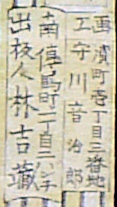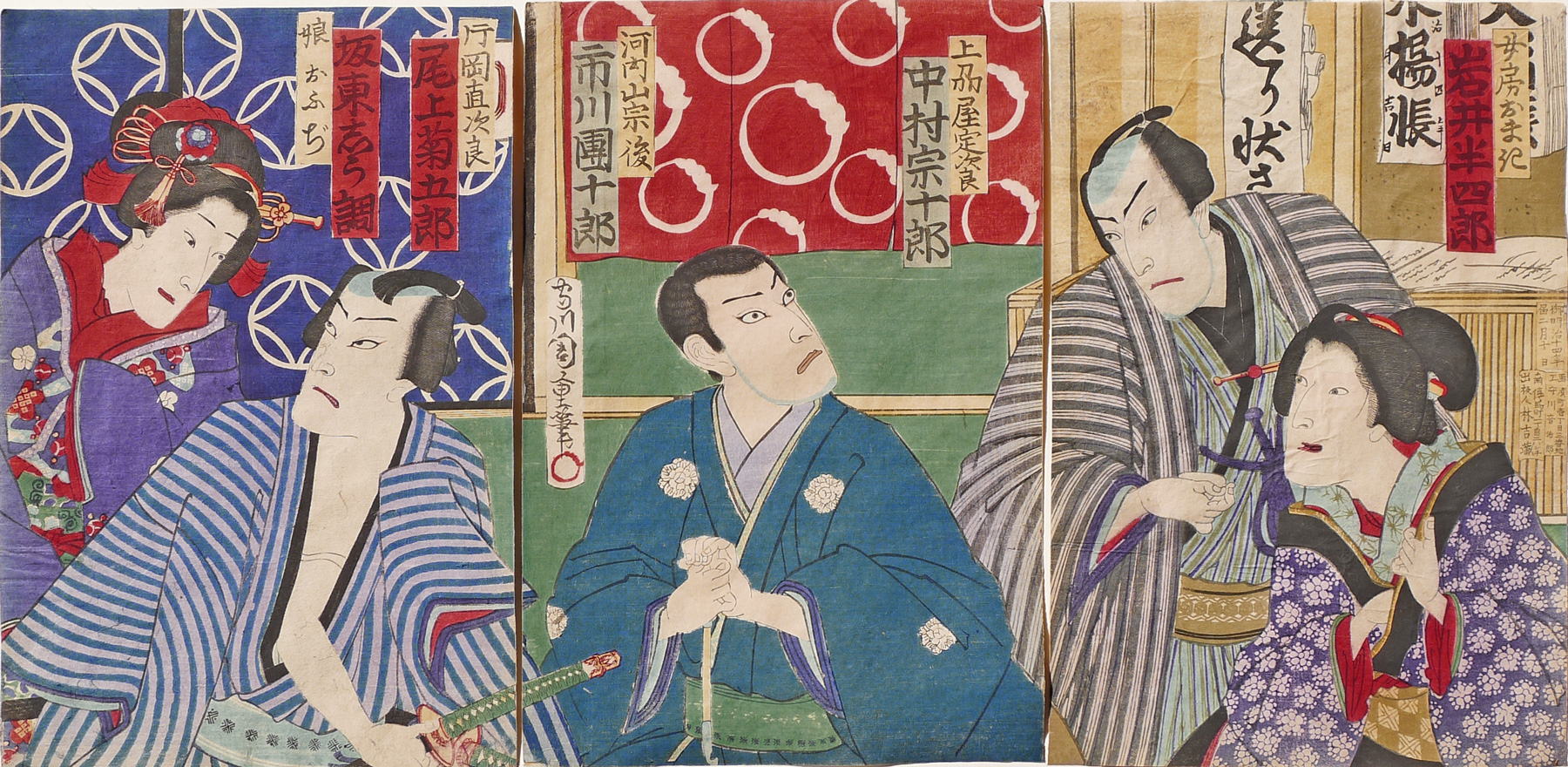About This Print
From right to left, the actors Iwai Hanshirō VIII 岩井半四郎 in the role of the courtesan Michitose 女房おま; Nakamura Sōjūrō 中村宗十郎 in the role of Jōshūya Sadajirō 上州屋定次郎; Ichikawa Danjūrō IX 市川団十郎 in the role of the bogus priest Kōchiyama Sōshun 河内山宗俊; Onoe Kikugorō V 尾上菊五郎 as Kataoka Naojirō 片岡直次郎, nicknamed Naozamurai - the "Faithful Samurai"; and Bandō Shiuka 坂東志う調 as Masume Ofuji (reading unconfirmed) 娘おふぢ in the play Kumo ni magō Ueno no hatsuhana 天衣粉上野初花, performed at the Shintomi-za 新富 theater, Tokyo, on March 31, 1881 (Meiji 14).Chikashige has used the Toshidama seal, denoting members of the Utagawa School, as the pattern on the red backdrop of the center panel.
The Play Kumo ni magō Ueno no hatsuhana by Kawatake Mokuami
"Kumo ni magō ueno no hatsuhana" is aSewamono depicting the lives of 6 bad men including Kōchiyama Sōshun andKataoka Naojirō. Kawatake Mokuami wrote this work while looking back withnostalgia on the Edo emotional mood which was being lost after the Meiji periodstarted.
This play became popular from its premier performance in which Ichikawa Danjūrō 9th played Kōchiyama and Onoe Kikugorō 5th played Naojirō.
Details
Source: Kabuki Encyclopedia, An English-Language Adaption of Kabuki Jiten, Samuel L. Leiter, Greenwood Press, 1979, p. 210-211
Kumo Ni Magō Ueno noHatsuhana. Kawatake Mokuami. Also called Kochiyama to Naozamurai, Kochiyama Michitose to Naozamurai. Seven acts, sixteen scenes. March 1881. Shintomi-za, Tokyo.
Kawatake Mokuami, dramatizerof the exploits of daring bandits (robber plays), based this work on astoryteller’s tale (kōdan) byMatsubayashi Hakuen, popularly known as Dorobo (“Thief”) Hakuen. The title of the tale was Tenpō Rokkasen. Since 1910 this play usually has beendivided into two parts and played separately as Kochiyama and Naozamurai(a fuller title for the later is Yuki noYube Iriya no Azemichi).
The play was first producedin 1874 at the Kawarazaki-za, but only a part of the full-length work wasperformed. Its title was Kumo no Ueno Sane no Sakumae. This play’s plot was incorporated in the Kochiyama section of the laterfull-length version. In 1881 the Naozamurai section was added, and theplay took the form that is now familiar. Onoe Kikugorō V played Naojirō and Iwai Hanshirō was Michitose. Others in the cast included Ichikawa DanjūrōIX, Ichikawa Sadanji, Nakamura Sōjūrō, and Ichikawa Sadanji V.
In order to rescue thedaughter of a townsman from the clutches of an evil nobleman, Lord Matsue,Kochiyama boldly enters the lord’s castle disguised as a priestly messengerfrom a temple at Ueno. Having arrangedfor the girl’s return to her father, he is on the point of leaving whenKitamura Daizen, a retainer of Matsue, recognizes him as Kochiyama theoutlaw. Kochiyama, however, switchesfrom his priestly manner and hurls a speech of defiance at his accusers; hethen exits with great composure. Allbreathe a sigh of relief, as Kochiyama had threatened to reveal Daizen’s past tothe police if anyone dared to arrest him.
In the second part, Naojirō(Naozamurai), pursued by the law, decides to flee Edo; caught in a snowstorm,he goes to an inn in Iriya to visit his love-sick mistress, the courtesanMichitose, before departing from the city. His fellow gang member Ushimatsu, however, secretly reveals Naojirō’swhereabouts to the police, and the fugitive is soon surrounded.
The major part of the Kochiyama scene comes when Kochiyamadelivers his famous diatribe using the colloquial Edo language of the time; Naozamurai is noted for its lovely kiyomoto musical accompaniment and amoving lamentation scene (kudoki)that is performed in dance-mime by Naozamurai and Michitose.
The Actors Pictured and Their Roles
For background on the actors see their respective entries in the article The Kabuki Actor on this site.
Print Details
| IHL Catalog | #1095 |
| Title (Description) | The actors Iwai Hanshirō VIII, Nakamura Sōjūrō, Ichikawa Danjūrō IX, Onoe Kikugorō V and Bandō Shiuka in the play Kumo ni magō Ueno no hatsuhana. |
| Artist | Morikawa Chikashige (active 1869 - January 1882) |
| Signature | Morikawa Chikashige hitsu 守川周重筆 |
| Seal | Toshidama seal below signature |
| Publication Date |  February 10, 1881 |
| Publisher |  |
| Impression | excellent |
| Colors | excellent |
| Condition | good - trimmed to image; 3 separate panels; rubbing; soiling, particularly in the right panel; minor ink offsetting; some remnants of previous backing paper |
| Genre | ukiyo-e; yakusha-e |
| Miscellaneous | |
| Format | vertical oban triptych |
| H x W Paper | 13 5/8 x 9 1/4 in. (34.6 x 23.5 cm) each sheet |
| Literature | |
| Collections This Print | Tokyo Metropolitan Library M348-26-2(1), (2), (3) |


